Chances Are, You Suck At This
You’re probably either doing the stiff knees:
or the rounded low back
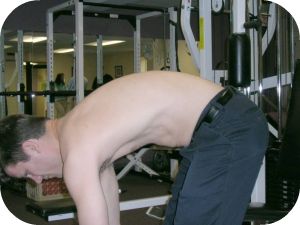 This is from CliftonParkchiro
This is from CliftonParkchiro
or both….
See Wha’ Had Happen Wazz
You’re all like the Tin Man.
We gotta change that, cause without some hips you’re gonna (probably) get some big time fugazi awesome feelings in your lower back. Now this is what hinging the hip looks like: 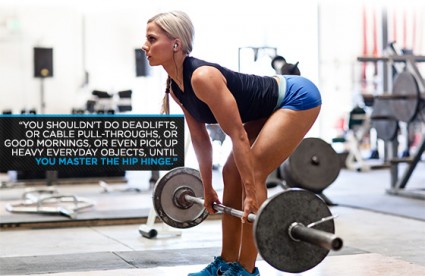
- Hips back
- Shins Vertical
- Chest “up”
- Straight line shoulders through hips
- Lower back in neutral
I know what you’re thinking, it’s either:
“ummm, people can’t do that?”
Or, more likely
“What the F- man, I can’t do that”
But you can, hell you have, probably like a bazillion times, you just stopped and your ass got lazy and weak….literally, you’re ass got weak.
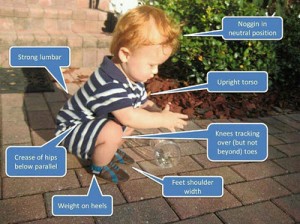 Gotta hinge hips to squat like this….from the PTDC.com
Gotta hinge hips to squat like this….from the PTDC.com
Point is Cause Some of You Might Not Be Following Along:
You Should be Able to Hinge and LOAD Your Hips.
Period, End of Story.
If you have a normal functioning back/ hip and can’t, something is wrong, we gotta fix that…
I’m going off generalizations and things I see often, this path may not be what works for you, sorry that’s just the way this stuff goes, different stuff works BEST for different people.
Step One: You Gotta Get Some Hips
If your ass is flat and the hip-joint is tight, we got some work to do. <—–hell, I’ve had plenty of people with a big ass who can’t do this..All Show, No Go…
Stand up: Squeeze your butt, don’t lean back, just squeeze your butt.
1: Nothing? Keep Reading <—- we gotta lot of work ahead of us
2: Something? Sit down and repeat
1: Nothing? Keep reading
2: Something? Skip to Mobility…
Personal Opinion: In the case of hips, you gotta get some Azzz before you can do anything else.
I guess it comes back to:
“You can’t stretch/ flex bone”
So we gonna build some awareness, A.K.A: ass cramps galore
What You Should Do:
1. Squeeze your butt throughout the day…..or at least try.
2. Do some glute activation exercises OFTEN, like everyday often, maybe twice a day often.
Now you aint gonna be all like Kim K. from these, but at least your brain will know that there actually is a muscle hanging out back there.
The key to all of these is being precise and concentrating.
You’re gonna want to move from the low back and use the hamstrings…..and, ummm, well, that’s kinda the point.
You’re not supposed to…so,
DON’T..
Concentrate, take your time and be deliberate.
Glute Bridge:
You should start with no barbell to get a feel, but you can progress to these pretty quickly and this video is more awesome so I used it.
If the two leg version is pretty easy and you don’t want to use weight or if you have uneven activation try the single leg version
Hip Extension over a Bench:
If you REALLY can’t fire a glute these help a lot because the low back is locked into the bench and can’t compensate.
If these are toooo easy try them on the forearms, but NO low back..
Glute Bridge Knee Outs:
If you have good glute activation these won’t be very difficult, although the kneeout exercises can be made MUCH harder by using a heavier band, but that’s not the point here.
The point is Ass Cramps, or at least some semblance of some butt squeezing.
Once you can squeeze we gotta start working on.
Mobility
Passive Mobility:
Loosen the tissues with a foam roller and/ or tennis/ lacrosse ball.
Quick note: Stop it with the spikey balls and the PVC pipes already.
I know you’ve done Starting Strength/ CrossFit/ Strong Lifts for the past 12 months AND read Supple Leopard so you are now officially an experts on all things fitness/ health/ wellness.
But this has gotten ridiculous.
Unless you’re extremely heavy/ dense with tissue and have been using these modalities for a loooooooooooooong time…
I’m talking YEARS <——-If you bought your first foam roller at Home Depot for $10 and were the only person you knew who had one, and have been training continuously for that time you probably qualify—> this is too much.
Seriously, you’re doing it wrong.
Besides the fact that too much pressure may induce a reflex reaction in the tissues and tighten the area up post rolling….
Remember, you adapt to ALL stressors placed on the body.
Why would you want to go as hard as possible as quickly as possible?
You don’t earn a prize for it…..it’s not a badge of honor.
Where do you go from a PVC pipe?
Anyway, loosen up the tissues with the least dense modality possible then stretch the area.
Glutes:
Hamstrings:
Hip Flexors:
Next Up…
Active Mobility:
First things first, we probably gotta get your hamstrings to shut down some.
There’s a good chance that they’re overactive and doing all the work your glutes were supposed to be doing in the first place.
Knowledge Bomb: Your hips need to be stable, they want to be stable, so you’re gonna do whatever it takes to hold them in place.
This is #1 why you need an ass and #2 why your hammies are tight.
Hamstrings can help stabilize the hip, if they gotta, they don’t want to, but will if you shut the glutes down long enough.
This is why the straight leg test (stolen from the FMS, and I saw Mike Robertson do it once) is so valuable.
WordPress is being a total D-Bag at the moment so click me for a video on how to test yourself
If you’re hamstring length is short of normal (that’s usually straight up and down)...try it again with distraction
….you probably wont be as short, do it for a couple of days/ weeks and low and behold you’ll probably normal, or at least waaaaaay better.
Why?
Cause the core stabilizes the hip also and the distraction turns the abzzz on, so the hammies can loosen up and stop worrying about the hip.
So Exactly why is this test/ exercise important:
Quick version:
- Hamstrings cross the hip
- they have to calm down so the Femur/ Pelvis can move freely without the hamstrings locking things down
- It also underscores the importance of a strong/ functioning core.
Then we’re going to start creating a hinging movement.
First on all Fours in Quadruped:
Yes, this is Muy easy, it’s supposed to be.
But it ONLY COUNTS if you can maintain a NEUTRAL lumbar spine…
If you’re lower back rounds over or the hips shift….
NO BUENO
Start over.
Then in Kneeling:
Then we’ll stand up and use the wall as a guide:
Once we can easily do this we move to loading.
Easily means:
- I don’t have to hold you in place.
- The low back doesn’t move on either end.
- The foot pressure doesn’t change. <—-you don’t flex the ankle and fall back.
Loading:
You MUST be conservative here….
Personally I like to start with bands:
Why?
Cause the bands deload at the point of the exercise where your back could be in jeopardy if it unlocks/ moves.
Band Pull Through:
Yes, I realize that’s a cable pull-through, this is one of those times you gotta make the leap and figure out how to make a cable pull through a band pull through…
Band Good Morning:
Loading: Phase 2
Here’s where you’re gonna have to stay tight all the way through and LOAD the hips.
Front Loaded RDL:
KB Deadlift:
Once you’re here…you probably have some hips can hinge like a MoFo and can start deadlifting with a bar and or Kettlebell Swings and maybe even Good Mornings With a Bar.
So why go through all this?
You’ll be stronger and safer.
Instead of lifting from the knees and low back you’ll be using your hips.
Knowledge Bomb: The knee is a small hinge joint the hip is a very large ball and socket joint.
Doesn’t it make sense that we would want to load/ move from the hip?
Now don’t get an idea that some of the “lower” level exercises are just for beginners.
They’re ALL really great exercises that can be used for many different things, warm-ups, accessory work, even main exercises, it’s just about context and loading.

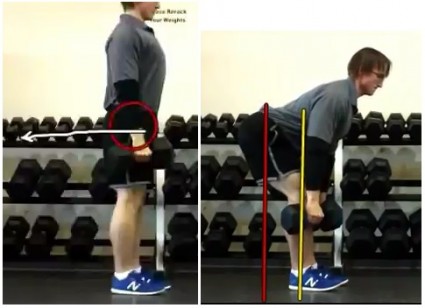

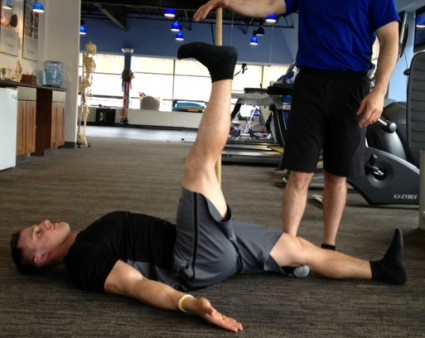
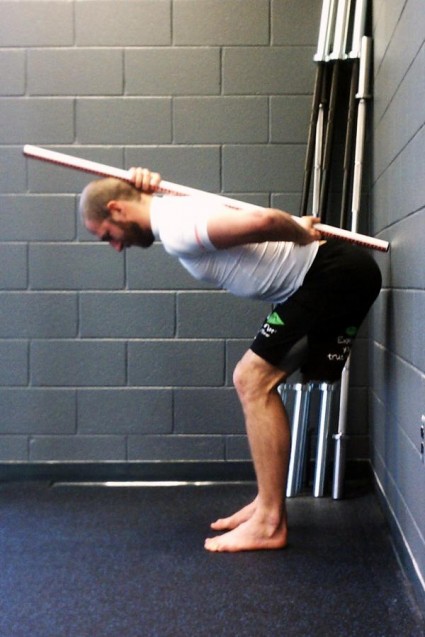


[…] Maybe you don’t… […]